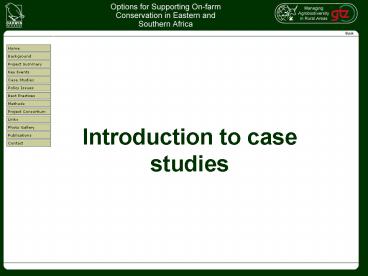Introduction to case studies PowerPoint PPT Presentation
1 / 19
Title: Introduction to case studies
1
Introduction to case studies
2
IPPM/FFS - Kenya
- Since 1999, 8 Districts Kenya, Uganda, Tanz.
- food security sustainable land use thru IPPM
FFS - 25,000 beneficiaries in 1,000 FFS
- FFS on foci model, training of trainers,
agro-ecosystem anal., HIV/AIDS awareness - Sustainable agriculture techniques variety
testing
3
IPPM/FFS - impact
- Whole farm biodiversity esp. insects, new crops,
varieties - Better understanding of biological control
ecosystem functions - ? income opps (yields,jobs,services)
- 25,000 farmers in 1,000 FFS (172 farmer-led, 16
self-sponsored)
4
IPPM/FFS institutional conditions
- Govt supports FFS approach e.g. making extension
staff available - altho 12,000, need for local
dialects, still top-down - Multiplier effect
- Institutional links/networking market, local
government
5
Mutoko CSB Zimbabwe
- 4 villages, SALRED, Mutoko, 1995
- conservation sustainable use for livelihood
enhancement - Community seed centres production, storage,
sales - Training in seed production, processing, business
management, leadership seed fairs green shows
introduction of new crops on-farm
characterization of landraces exchange visits
6
Mutoko CSB - impact
- 35 new FVs, 19 new MVs, 2 new crops
- ? indigenous and new knowledge
- ? livelihoods income, esp. food seed security
- 4 CSBs, 170 farmers
- Strong participation farmers at centre of
planningmanagt, incl. women - ? activity 2001 onwards
7
Mutoko CSB institutional conditions
- Built on traditional structures zunde ramambo
traditional authorities - Community ownership and empowerment
- Networking with other organisations for training,
seed supply, etc - High social networking
- So why scaled down after 2001?
8
IPGRI/FAO Zimbabwe
- 1997 in Zimbabwe and Mali incl Tcholotcho, 120km
Bulawayo - conservation measurement (surveys) farmer,
molecular, GIS), research support - Two Wards, ? farmers
- Seed fairs, seed banks, farmer field fora
9
IPGRI/FAO - impact
- Marginal ? varieties all improved 4 MVs
replaced 5 FVs of sorghum - Knowledge thru farmer field fora only
- Livelihoods prizes, what else?
- Seed fairs ? interaction (highly valued), but not
much control
10
IPGRI/FAO institutional conditions
- Traditionally strong community sharing and
pulling together - Shifting objectives staff changes
- Poor communication channels top-down
- Long funding chain
- Limited/conflicting incentives
- Inadequate capacity building for community
control eg seed fairs - Drought, politics
11
EOSA Ethiopia
- Since 2002, various sites nationwide incl. Ejere
- conservation thru organic farming marketing
- 530 farmers at Ejere
- community seed supply (loans, seed banks),
organic production techniques, market links to
national international
12
EOSA - impact
- Increased on-farm biodiversity (total), enhanced
farmers varieties, focussing on durum wheat - Positive impact on livelihoods production,
income, access to markets - Integrated modern trad. production
conservation systems - 530 ? 1,000 farmers. Improved coordination
organisation thru community groups training,
demo plots
13
EOSA institutional conditions
- Long-standing relationships (since 1994)
- Appropriate technologies
- Potentially sustainable funding from industry
(strong links) - 20-30 price premium 40,000 t p.a. unfilled
demand - Poor infrastructure
- Increasing climatic variability
- Policy environment
- Limited availability of seed staff
14
Ipongo Zambia
- Since 1994, 188km NW of Lusaka
- food security through adapted IRDP
- 1,000 farmers in 36 farmers clubs
- Micro-credit revolving fund for seed, cattle,
cash extension CAWs for sust. agriculture - Farmer seed multiplication, CSBs, on-farm
storage, seed fairs
15
Ipongo - impact
- 10-13 (modern) varieties, min. 2 new crops
- Ecological farming building on local knowledge
- ? ha, 50 farmers food secure but local
infrastructure - 1,000 farmers in 36 clubs (1 out of 5)
- Goalself-managing CBO
16
Ipongo institutional conditions
- Grassroots empowerment
- Appropriate agricultural techniques
- local service delivery
- Price negotiation in agribusinesses
- Local infrastructure inadequate
17
OPPAZ - Zambia
- Since 1999, Kabwe, Mazabuka, Mpongwe
- income generation thru organics for export
- 70 large farmers, 4,500 small farmers in 48
groups - Advice on all aspects organic production
marketing, organic ag. research, certification
18
OPPAZ - impact
- Promotes targetted field cash crops (esp.
groundnut), high value spp. (essential oils)
wild plants (moringa) - Knowledge of organic production
- Household incomes (untapped potential)
- 4,500 small farmer members
19
OPPAZ institutional conditions
- High international demand
- Staff commitment
- Multiple national partnerships
- Market liberalisation
- Diverse requests, limited resources
- Export delays
- EU organic import regulations

